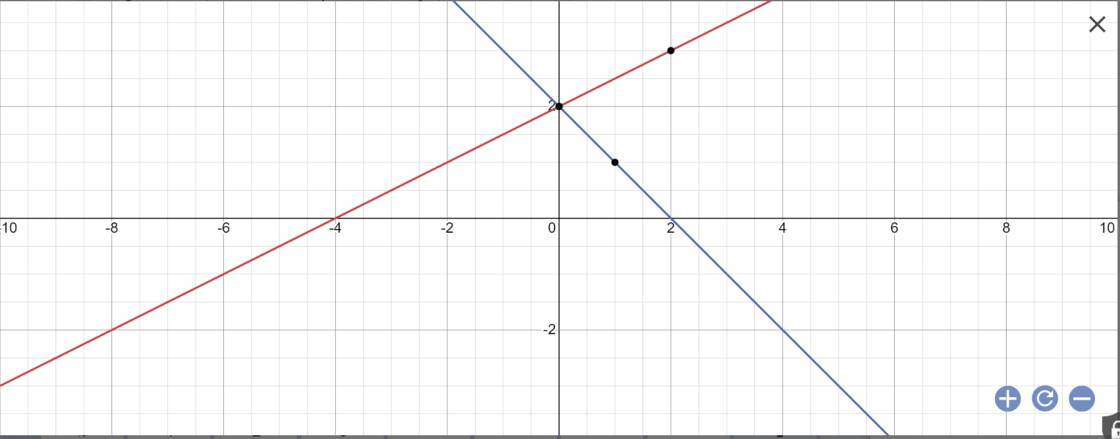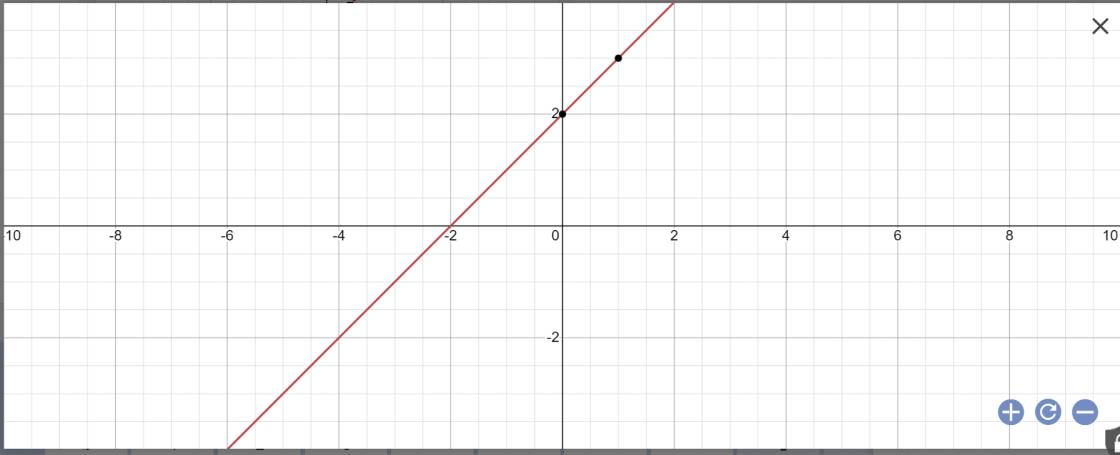Hãy nhập câu hỏi của bạn vào đây, nếu là tài khoản VIP, bạn sẽ được ưu tiên trả lời.

a: Tọa độ giao điểm là:
\(\left\{{}\begin{matrix}x-1=-x+3\\y=x-1\end{matrix}\right.\Leftrightarrow\left\{{}\begin{matrix}x=2\\y=1\end{matrix}\right.\)

a: Thay x=1 và y=-2 vào y=ax+1, ta được:
a+1=-2
hay a=-3
Vậy: (d'): y=-3x+1
c: Tọa độ giao điểm của (d) và (d') là:
\(\left\{{}\begin{matrix}-3x+1=x+3\\y=x+3\end{matrix}\right.\Leftrightarrow\left\{{}\begin{matrix}x=-\dfrac{1}{2}\\y=3-\dfrac{1}{2}=\dfrac{5}{2}\end{matrix}\right.\)

a:

b: Gọi \(\alpha\) là góc tạo bởi (d1) với trục Ox
(d1): \(y=\dfrac{1}{2}x+2\)
=>\(a=\dfrac{1}{2}\)
=>\(tan\alpha=a=\dfrac{1}{2}\)
=>\(\alpha\simeq26^034'\)
c: Tọa độ A là:
\(\left\{{}\begin{matrix}y=0\\\dfrac{1}{2}x+2=0\end{matrix}\right.\)
=>\(\left\{{}\begin{matrix}\dfrac{1}{2}x=-2\\y=0\end{matrix}\right.\Leftrightarrow\left\{{}\begin{matrix}x=-4\\y=0\end{matrix}\right.\)
Tọa độ B là:
\(\left\{{}\begin{matrix}y=0\\-x+2=0\end{matrix}\right.\Leftrightarrow\left\{{}\begin{matrix}y=0\\-x=-2\end{matrix}\right.\Leftrightarrow\left\{{}\begin{matrix}x=2\\y=0\end{matrix}\right.\)
Tọa độ C là:
\(\left\{{}\begin{matrix}\dfrac{1}{2}x+2=-x+2\\y=-x+2\end{matrix}\right.\Leftrightarrow\left\{{}\begin{matrix}\dfrac{3}{2}x=0\\y=-x+2\end{matrix}\right.\)
=>\(\left\{{}\begin{matrix}x=0\\y=-0+2=2\end{matrix}\right.\)
Vậy: A(-4;0); B(2;0); C(0;2)
\(AB=\sqrt{\left(2+4\right)^2+\left(0-0\right)^2}=6\)
\(AC=\sqrt{\left(0+4\right)^2+\left(2-0\right)^2}=\sqrt{4^2+2^2}=2\sqrt{5}\)
\(BC=\sqrt{\left(0-2\right)^2+\left(2-0\right)^2}=\sqrt{2^2+2^2}=2\sqrt{2}\)
Chu vi tam giác ABC là:
\(C_{ABC}=AB+AC+BC=6+2\sqrt{5}+2\sqrt{2}\)(cm)
Xét ΔABC có \(cosBAC=\dfrac{AB^2+AC^2-BC^2}{2\cdot AB\cdot AC}=\dfrac{36+20-8}{2\cdot6\cdot2\sqrt{5}}=\dfrac{48}{24\sqrt{5}}=\dfrac{2}{\sqrt{5}}\)
=>\(sinBAC=\sqrt{1-cos^2BAC}=\dfrac{1}{\sqrt{5}}\)
Diện tích tam giác ABC là:
\(S_{ABC}=\dfrac{1}{2}\cdot AB\cdot AC\cdot sinBAC\)
\(=\dfrac{1}{2}\cdot6\cdot2\sqrt{5}\cdot\dfrac{1}{\sqrt{5}}=6\)

a:

b:
Sửa đề: Tính diện tích tam giác ABO
tọa độ A là:
\(\left\{{}\begin{matrix}y=0\\x+2=0\end{matrix}\right.\)
=>\(\left\{{}\begin{matrix}x=-2\\y=0\end{matrix}\right.\)
Vậy: A(-2;0)
Tọa độ B là:
\(\left\{{}\begin{matrix}x=0\\y=x+2\end{matrix}\right.\Leftrightarrow\left\{{}\begin{matrix}x=0\\y=0+2=2\end{matrix}\right.\)
Vậy: B(0;2)
O(0;0) A(-2;0); B(0;2)
\(OA=\sqrt{\left(-2-0\right)^2+\left(0-0\right)^2}=\sqrt{4}=2\)
\(OB=\sqrt{\left(0-0\right)^2+\left(2-0\right)^2}=\sqrt{4}=2\)
\(AB=\sqrt{\left(0+2\right)^2+\left(2-0\right)^2}=2\sqrt{2}\)
Vì \(OA^2+OB^2=AB^2\)
nên ΔOAB vuông tại O
=>\(S_{OAB}=\dfrac{1}{2}\cdot OA\cdot OB=\dfrac{1}{2}\cdot2\cdot2=2\)
c: Sửa đề: Tính góc tạo bởi đường thẳng với trục ox
Gọi \(\alpha\) là góc tạo bởi đường thẳng y=x+2 với trục Ox
\(tan\alpha=a=1\)
=>\(\alpha=45^0\)
Tan của góc tạo bởi d và Ox bằng hệ số góc của d
\(\Rightarrow tan\alpha=-\sqrt{3}\Rightarrow\alpha=-60^0\)
\(\Rightarrow\) Góc nhọn bằng 60 độ